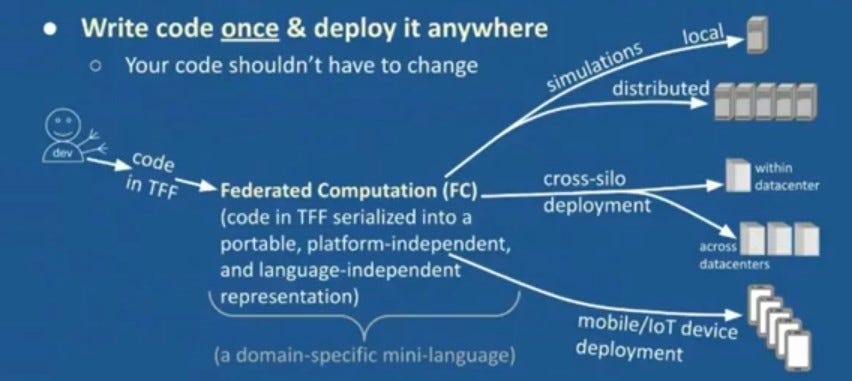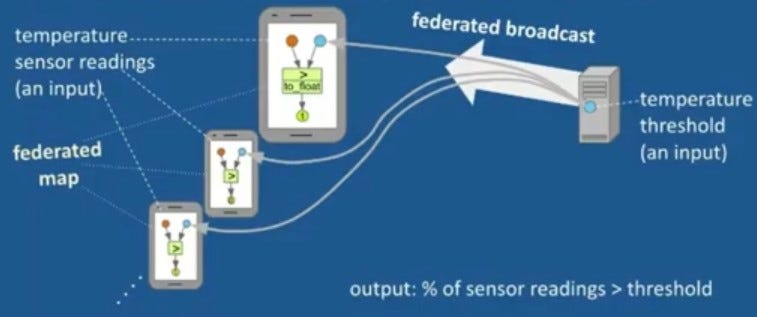
What’s in the TensorFlow Federated(TFF) box?
Last Updated on February 1, 2021 by Editorial Team
Author(s): Bala Priya
Machine Learning
Based on Krzysztof Ostrowski’s talk at OpenMined Privacy Conference 2020

Krzysztof Ostrowski is a Research Scientist at Google, where he heads the TensorFlow Federated development team. This blog post is inspired by his talk at the OpenMined Privacy Conference.
Outline
- What is TensorFlow Federated?
- Design Goals for TFF(TensorFlow Federated)
- Understanding the characteristics of Federated Computations(FC)
- TFF’s Canned and Simulation APIs
- Canned TFF Executors
- Collaboration opportunities for Open Source contributors
- References
What is TensorFlow Federated?
TensorFlow Federated(TFF) is a new development framework for Federated Computations, that typically involve computations on data that is born decentralized and stays decentralized. TFF provides a common framework for federated computations in both research and production and is an open-source project within the TensorFlow ecosystem.
What’s inside the TensorFlow Federated library?
- Federated Computation API(FC API) provides new abstractions, execution models and language designed for federated computations.
- Higher-level libraries and canned APIs that provide implementations of federated learning algorithms.
- Runtime and Simulation Components that provide datasets, canned training loops and single to multi-machine runtime capabilities, including flexible integration points for custom backend.
Design Goals for TFF
The TFF library has been designed so as to facilitate an easy path from research to production. In TFF, the code is serialized into a portable, language-independent and platform-independent representation.
The design is, therefore, motivated by the dictum:
Write code once, and deploy it anywhere;
Your code shouldn’t have to change!

Understanding the characteristics of Federated Computations(FC)
In this section, we shall seek to understand some of the characteristics of federated computations.
- Distributed Programming for privacy, anonymity and scale: In such systems, the client stays on-device, because it’s very sensitive. We can have millions of clients coming and going continuously. The clients are assumed to be anonymous, unreliable and stateless. No client IDs are allowed in computation. There are no one-to-one interactions between clients, only collective operations are involved.
Let us consider the example given in the illustration below.
Let us assume that temperature sensor readings of client devices are sensitive; The server wishes to get the percentage of client devices whose temperature sensor readings exceed a certain threshold. There’s federated broadcast of the threshold to all client devices. The client devices run a simple threshold check and send out a 1/0 depending on whether temperature > threshold is True/False respectively. The server then does federate averaging on the values from the clients, which gives the fraction of devices whose temperature exceeds the threshold.

- Clients and Server bear complementary responsibilities — the server orchestrates the training process, while the clients perform the bulk of processing, such as model training.
- Slicing and Dicing distributed (federated) values: A value is ‘federated’ if it can exist in multiple places. In our example, we may think of ‘temperature readings’ as federated float32@clients
- Involves communication and orchestration — collective operations, known as federated ops, rather than dealing with individual client’s data.
TFF’s Federated Computation API
The program flow is expressed in a Pythonic way for better interpretability. As stated in an earlier section, all code is traced and serialized at definition time to a platform-independent representation. Here’s the code snippet showing the collective operations and on-device processing for the temperature sensor example discussed above.
@tf.function
def exceeds_threshold_fn(reading,threshold):#on-device processing
return tf.to_float(reading > threshold)
@tff.federated_computation
def get_fraction_over_threshold(readings, threshold):
return tff.federated_mean( #collective operations
tff.federated_map( #collective communication
tff.tf_computation(exceeds_threshold_fn),
[readings, tff.federated_broadcast(threshold)]))
TFF’s Canned and Simulation APIs
We shall enumerate some of the features of TFF’s Canned and Simulation APIs.
- One-line call to create portable TFF code for federated training.
# Just plug in your Keras model
train = tff.learning.build_federated_averaging_process(...)
- To run a simulation, we can invoke just like a Python function, similar to the example below; By default, a single-machine in-process TFF runtime is spawned in the background.
state = train.initilaize()
for _ in range(5):
train_data = _ #pick random clients
state, metrics = train.next(state, train_data)
print(metrics.loss)
Canned TFF Executors
Canned TFF Executors provide support for the most common scenarios. A single-machine, multi-threaded execution is spawned by default in the background, and the Canned TFF Executors facilitate remote and distributed execution. TFF executor building blocks are reusable, stackable modules that add to individual capabilities and are specifically designed for extensibility and customizability.
Collaboration opportunities for Open Source contributors
There are opportunities to contribute to the federated algorithms suite, simulation infrastructure and more flexible runtime integrations.
References
[1] https://www.tensorflow.org/federated
[2] Krzysztof Ostrowski, TensorFlow Federated, OpenMined Privacy Conference,2020
[3] Here’s the link to the blog that I wrote for OpenMined.
What’s in the TensorFlow Federated(TFF) box? was originally published in Towards AI on Medium, where people are continuing the conversation by highlighting and responding to this story.
Published via Towards AI
Take our 90+ lesson From Beginner to Advanced LLM Developer Certification: From choosing a project to deploying a working product this is the most comprehensive and practical LLM course out there!
Towards AI has published Building LLMs for Production—our 470+ page guide to mastering LLMs with practical projects and expert insights!

Discover Your Dream AI Career at Towards AI Jobs
Towards AI has built a jobs board tailored specifically to Machine Learning and Data Science Jobs and Skills. Our software searches for live AI jobs each hour, labels and categorises them and makes them easily searchable. Explore over 40,000 live jobs today with Towards AI Jobs!
Note: Content contains the views of the contributing authors and not Towards AI.














